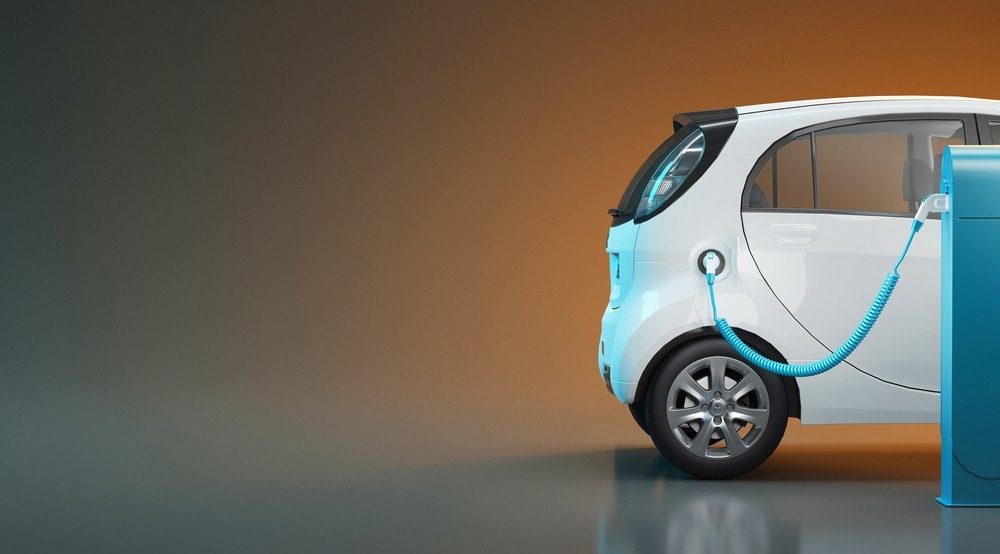A Harvard startup has designed a novel multi-layered solid-state electric vehicle battery that completely recharges in three minutes and lasts over twice as long as current electric vehicle batteries. Estimates suggest that the global transition toward electric vehicles would reduce carbon emissions by 16%, and this new battery design would be crucial to attaining this objective.

Image Credit: ALDECA studio/Shutterstock.com
How Do Electric Car Batteries Work?
An electric vehicle obtains its power directly from a large pack of batteries instead of burning fuel or gasoline such as an internal combustion engine.
The lithium-ion battery generates power by creating a potential difference between two electrodes submerged in an electrolyte, which drives the electrons between the electrodes.
Lithium Ion Batteries
Lithium-ion batteries are one technological advancement that has contributed to the popularity of electric cars over the past decade.
Most EV batteries were made from lead-acid and required a short burst of electricity to start a vehicle's motor before being recharged by an onboard generator. They were commonly referred to as starting, lighting, and ignition (SLI) batteries because they were never designed to discharge more than a small fraction of their capacity.
Li-ion batteries were initially limited to smartphones and laptops. But due to their capacity to handle a much higher energy density and the recent technological advancement, they are now used to power electric vehicles.
Limitations of Lithium-Ion Batteries
Current lithium-ion batteries are costly, heavy, slow to charge, and degrade over time. Furthermore, these batteries have a limited lifetime of seven to eight years.
While it just takes a few minutes to refuel a gasoline-powered vehicle, a fully-charged electric vehicle can take four to twenty-four hours or even a full day, depending on the quality of the electric vehicle battery charging device.
Therefore, long-lasting and quick-charging batteries are crucial for the growth and widespread adoption of electric vehicles.
Adden Energy's Long-Lasting Ultra-Fast Charging Batteries
For decades, scientists have tried to harness the potential of lithium-metal solid-state batteries due to their high energy density, high thermal stability, and rapid charging capability.
Adden Energy, a startup led by Harvard engineers Xin Li, William Fitzhugh and Luhan Ye, has reportedly designed a long-lasting, ultra-fast charging battery that might revolutionize the EV industry.
Stable, quick-charging
Li and his colleagues have designed a solid-state lithium battery that can be fully charged in three minutes. The new battery offers a high energy density and material stability that addresses the safety issues of conventional lithium-ion batteries.
Long-lasting
Current lithium-ion EV batteries degrade over time and have an average life span of seven or eight years. But this new solid-state lithium-metal battery has a service life of more than 10,000 cycles, which means it can last up to 20 years.
Innovative design to counter dendrite formation
The chemical composition of lithium-metal batteries has always posed significant challenges. During charging, the movement of Li ions from the cathode to the anode causes the formation of dendrites. These needle-like structures penetrate the barrier separating the anode and cathode and grow in the electrolyte, causing the EV battery to short circuit or even catch fire.
To address this issue, Li and his colleagues designed an innovative multi-layered battery that sandwiched several materials of various stabilities between the cathode and anode. This multilayer design prevented the penetration of dendrites by inhibiting their growth rather than containing and controlling them.
The Future of EV Batteries
One of the automobile industry's primary goals in recent years has been to make electric vehicles more accessible because very few EVs are readily available to the general public due to their high cost and charging equipment requirements.
The Aden Energy startup has secured a technology license from the Office of Technology Development (OTD) at Harvard University and funding of 5.15 million USD. The venture capital and license will enable the commercial production of solid-state batteries, eventually making electric vehicles more accessible.
Making electric vehicles more accessible to the public would accelerate the global transition toward clean energy and reduce greenhouse gas emissions, paving the way toward a greener future.
References and Further Reading
Cuthbertson, A. (2022). 'Game-changing' New Battery Charges in 3 Minutes and Lasts 20 Years. [Online]. Independent. https://www.independent.co.uk/tech/battery-charge-record-electric-car-b2166102.html (Accessed on 18 September 2022).
Harvard John A. Paulson School of Engineering and Applied Sciences. (2021). A long-lasting, stable solid-state lithium battery: Researchers demonstrate a solution to a 40-year problem. ScienceDaily. Retrieved from: www.sciencedaily.com/releases/2021/05/210512115651.htm (Accessed on 18 September 2022).
Perry, C. (2022). Fast charging over 10,000 cycles: For future electric vehicles, Harvard Engineers' Solid-State Battery Technology Points To a Leap in Performance and Reliability. [Online]. Harvard SEAS. Available at: https://www.seas.harvard.edu/news/2022/09/fast-charging-over-10000-cycles-future-electric-vehicles-harvard-engineers-solid-state?fbclid=IwAR0tQXOU99MOKpYyfkkof7RjOfLe4M4pP8lHWnBF-huCkGvHuMk9kyajvx4 (Accessed on 18 September 2022).
Randall, C. (2022). Adden Energy Achieves Breakthrough In Solid-State Battery Development. [Online]. Electrive.com. https://www.electrive.com/2022/09/13/adden-energy-achieves-breakthrough-in-solid-state-battery-development/ (Accessed on 18 September 2022).
Renault Group. (2019). 'Game-Changing' New Battery Charges In 3 Minutes and Lasts 20 Years the Electric Car: How Does Its Lithium-Ion Battery Work? [Online]. https://www.renaultgroup.com/en/news-on-air/news/the-electric-car-how-does-its-lithium-ion-battery-work/ (Accessed on 18 September 2022).
Ye, L. & Li, X. (2021). A Dynamic Stability Design Strategy for Lithium Metal Solid State Batteries. Nature. https://doi.org/10.1038/s41586-021-03486-3
Disclaimer: The views expressed here are those of the author expressed in their private capacity and do not necessarily represent the views of AZoM.com Limited T/A AZoNetwork the owner and operator of this website. This disclaimer forms part of the Terms and conditions of use of this website.